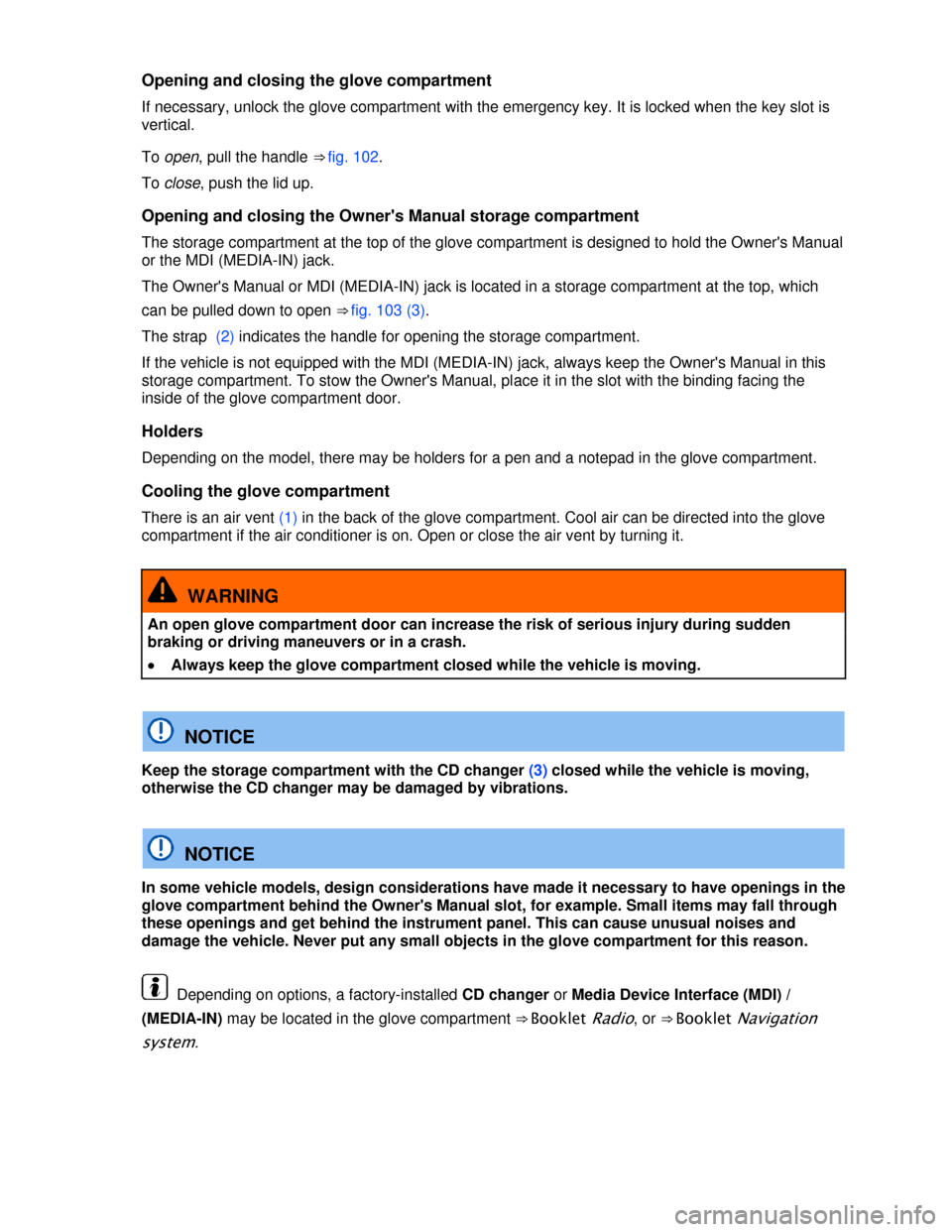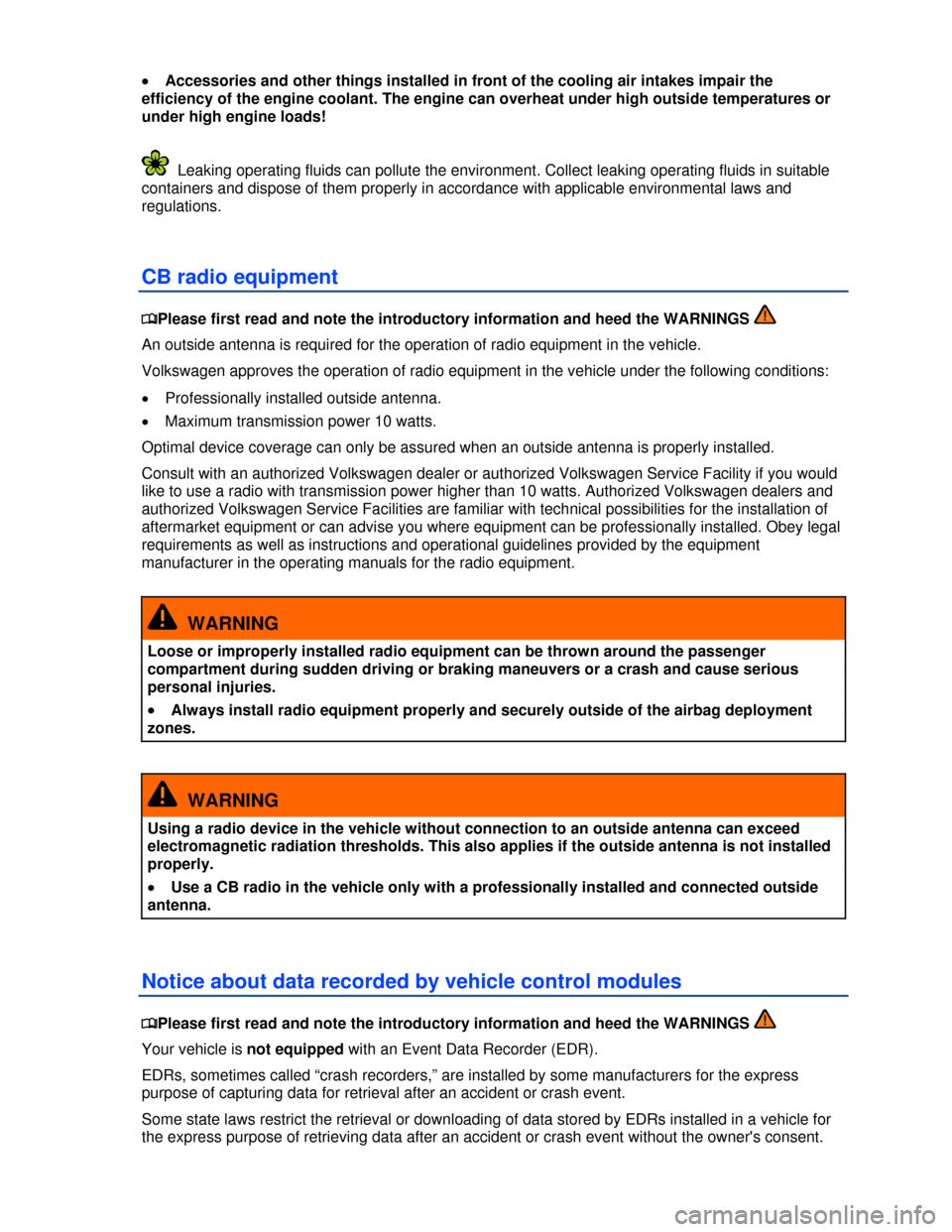cooling VOLKSWAGEN PASSAT CC 2013 1.G Owners Manual
[x] Cancel search | Manufacturer: VOLKSWAGEN, Model Year: 2013, Model line: PASSAT CC, Model: VOLKSWAGEN PASSAT CC 2013 1.GPages: 353, PDF Size: 5.56 MB
Page 156 of 353

Opening and closing the glove compartment
If necessary, unlock the glove compartment with the emergency key. It is locked when the key slot is
vertical.
To open, pull the handle ⇒ fig. 102.
To close, push the lid up.
Opening and closing the Owner's Manual storage compartment
The storage compartment at the top of the glove compartment is designed to hold the Owner's Manual
or the MDI (MEDIA-IN) jack.
The Owner's Manual or MDI (MEDIA-IN) jack is located in a storage compartment at the top, which
can be pulled down to open ⇒ fig. 103 (3).
The strap (2) indicates the handle for opening the storage compartment.
If the vehicle is not equipped with the MDI (MEDIA-IN) jack, always keep the Owner's Manual in this
storage compartment. To stow the Owner's Manual, place it in the slot with the binding facing the
inside of the glove compartment door.
Holders
Depending on the model, there may be holders for a pen and a notepad in the glove compartment.
Cooling the glove compartment
There is an air vent (1) in the back of the glove compartment. Cool air can be directed into the glove
compartment if the air conditioner is on. Open or close the air vent by turning it.
WARNING
An open glove compartment door can increase the risk of serious injury during sudden
braking or driving maneuvers or in a crash.
�x Always keep the glove compartment closed while the vehicle is moving.
NOTICE
Keep the storage compartment with the CD changer (3) closed while the vehicle is moving,
otherwise the CD changer may be damaged by vibrations.
NOTICE
In some vehicle models, design considerations have made it necessary to have openings in the
glove compartment behind the Owner's Manual slot, for example. Small items may fall through
these openings and get behind the instrument panel. This can cause unusual noises and
damage the vehicle. Never put any small objects in the glove compartment for this reason.
Depending on options, a factory-installed CD changer or Media Device Interface (MDI) /
(MEDIA-IN) may be located in the glove compartment ⇒ Booklet Radio, or ⇒ Booklet Navigation
system.
Page 264 of 353

If more antifreeze protection is needed for climate conditions, the percentage of coolant additive can
be increased. However, the coolant additive percentage must never be more than 60%; otherwise,
antifreeze protection is reduced and the ability of the mixture to cool the engine is also reduced.
When adding engine coolant, use a mixture of distilled water and at least 40% coolant additive G 13
or G 12 plus-plus (TL-VW 774 G) for optimum corrosion protection ⇒ .
Do not mix G 13 with G 12 plus or G 11. Mixing these coolant additives together significantly reduces
corrosion protection ⇒ and can lead to engine damage that is not covered by any Volkswagen
Limited Warranty.
WARNING
Too little antifreeze protection in the engine cooling system can cause engine failure and
severe injuries.
�x Always make sure there is enough of the correct coolant additive to provide proper
antifreeze protection at the coldest temperatures that can be expected where the vehicle will
be used.
�x At extremely cold temperatures, the coolant could freeze, causing the vehicle to break
down. The heater would also not work, and vehicle occupants could be without protection at
subfreezing temperatures.
NOTICE
Never mix original Volkswagen engine coolant additives with other additives not approved by
Volkswagen. Mixing Volkswagen coolant additives with coolant additives made by other
manufacturers can seriously damage the engine and the engine cooling system.
�x If the fluid in the engine coolant reservoir is any color but pink, then G 13 was mixed with a
different engine coolant. If this is the case, the engine coolant must be replaced immediately.
Otherwise serious malfunctions or engine damage can occur!
Engine coolant and engine coolant additives can pollute the environment. Collect leaking
operating fluids and dispose of them properly in accordance with applicable environmental laws and
regulations.
Page 300 of 353

�x Accessories and other things installed in front of the cooling air intakes impair the
efficiency of the engine coolant. The engine can overheat under high outside temperatures or
under high engine loads!
Leaking operating fluids can pollute the environment. Collect leaking operating fluids in suitable
containers and dispose of them properly in accordance with applicable environmental laws and
regulations.
CB radio equipment
�